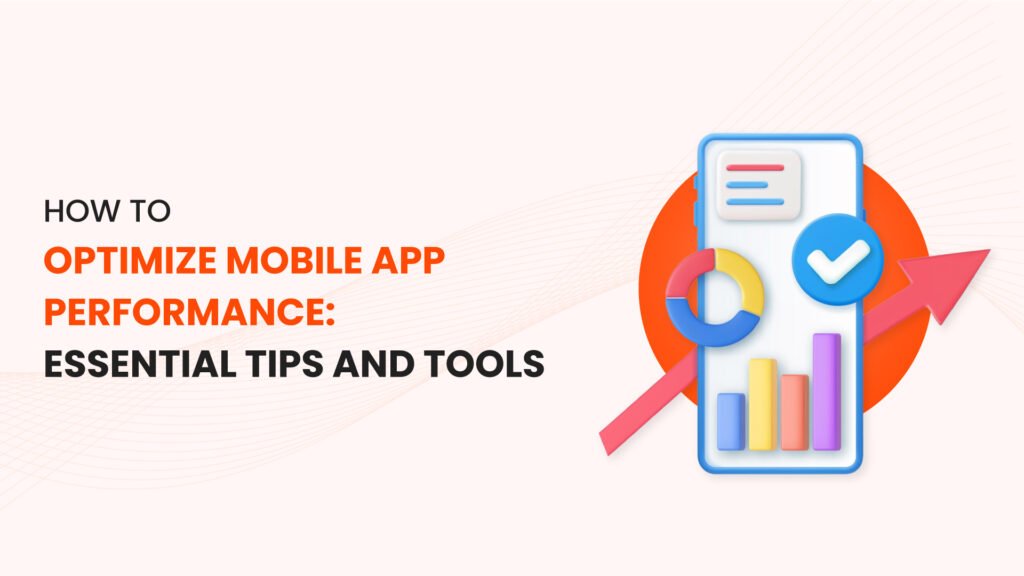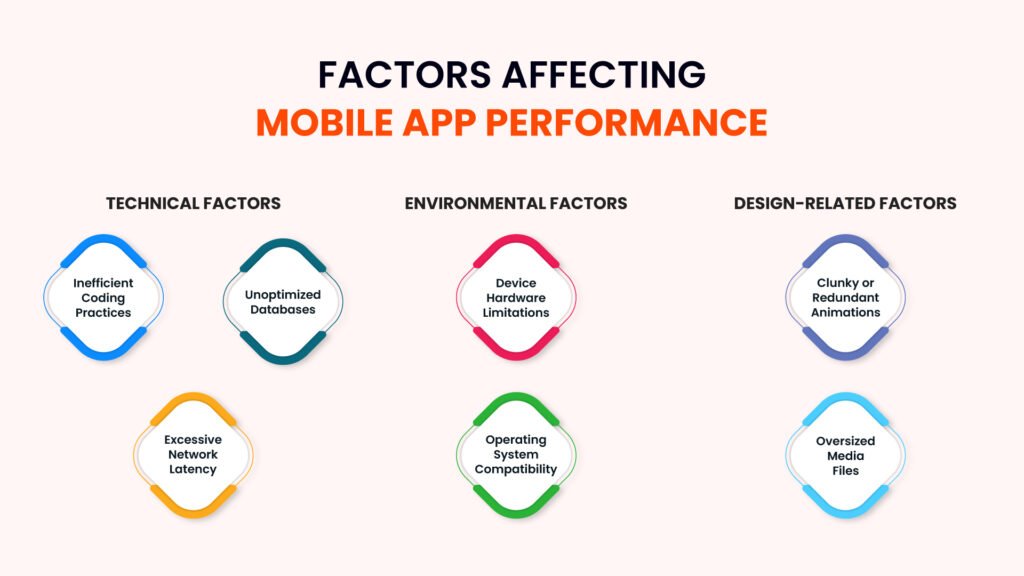
Mobile app performance directly influences user retention, engagement, and satisfaction. An app that lags or crashes can drive users away faster than any competitor. This article dives into how to optimize mobile app performance, ensuring your app stays responsive and efficient.
Mobile app performance is a critical factor in determining the success of an application. A well-performing app keeps users engaged, while a slow or buggy app leads to uninstalls, negative reviews, and poor retention.
For instance, research shows that 53% of users abandon apps that take longer than 3 seconds to load. Optimizing mobile app speed and efficiency isn’t just about improving numbers; it’s about creating seamless experiences that drive long-term loyalty.
This guide covers essential strategies and tools to help developers optimize their apps effectively.
Why Mobile App Performance Matters
The Impact on User Experience and Retention
Mobile app users demand quick, seamless functionality. When apps fail to meet these expectations, frustration builds, and retention drops. A lagging app not only creates dissatisfaction but also diminishes trust in the brand.
- Key Statistics:
- A delay of just one second in app load time can lead to a 7% drop in conversions.
- Poor app performance is a leading cause of user churn, with users often abandoning apps that don’t perform as expected.
Influence on App Store Rankings
App performance plays a crucial role in determining an app’s visibility on platforms like Google Play and the Apple App Store. Metrics such as load speed and crash rates directly affect rankings. A higher ranking results in greater visibility and more downloads, while poor performance leads to reduced discoverability.
Factors Affecting Mobile App Performance

To address app performance issues, it’s essential to understand the key factors causing them. These factors fall into three main categories:
1. Technical Factors
- Inefficient Coding Practices: Overcomplicated or poorly written code can bog down app functionality.
- Unoptimized Databases: Large, unstructured databases can slow queries and data retrieval.
- Excessive Network Latency: Slow server responses or network connectivity issues can degrade app performance.
2. Environmental Factors
- Device Hardware Limitations: Older devices or low-spec hardware can struggle to handle modern app demands.
- Operating System Compatibility: Incompatibilities between the app and various OS versions can cause crashes or glitches.
3. Design-Related Factors
- Clunky or Redundant Animations: Overly complex or unnecessary animations can slow rendering speeds.
- Oversized Media Files: Large images, videos, or audio files can increase load times and consume more resources than necessary.
Steps For How to Optimize Mobile App Performance
4.1 Optimize App Loading Speed
A fast-loading app is essential for retaining users and ensuring a smooth experience. Here are key ways to achieve it:
- Implement Lazy Loading: Load only the content users need at any given moment, reducing initial load time and saving resources.
- Reduce App Size: Compress images, videos, and other files to minimize storage requirements. Eliminate unused resources or redundant assets.
- Monitor Performance: Use tools like Firebase Performance Monitoring to identify and address bottlenecks in your app’s load process.
- Asynchronous Loading: Load scripts and resources asynchronously to prevent blocking the main thread and ensure faster rendering.
4.2 Minimize Network Requests
Reducing unnecessary server interactions not only speeds up the app but also enhances user experience.
- Enable Data Caching: Store frequently used data locally so the app doesn’t rely on constant server requests.
- Compress Data Payloads: Optimize data formats such as JSON or XML to reduce the size of data transfers, minimizing transfer times.
- Leverage CDNs: Content Delivery Networks ensure assets like images, videos, and scripts are delivered quickly by serving them from servers closer to the user’s location.
- Optimize API Calls: Reduce the frequency and size of API calls by combining multiple requests into a single call whenever possible.
4.3 Improve App Rendering Efficiency
Smooth rendering is critical for a visually appealing and responsive app.
- Optimize Images and Media: Use formats like WebP for images, and adjust resolutions to maintain quality while minimizing file size.
- Adopt Lightweight Libraries: Select libraries and frameworks designed for performance to avoid bloating your app’s codebase.
- Streamline Code: Regularly audit and remove unused or redundant code to make the app leaner and faster.
- Use Hardware Acceleration: Leverage GPU capabilities for animations and complex visual elements to enhance rendering speed.
4.4 Optimize for Cross-Device Compatibility
An app’s performance can vary greatly depending on the device and platform. Ensuring compatibility is key to broader user satisfaction.
- Test Across Platforms: Tools like BrowserStack and TestFlight allow developers to simulate app performance on different devices and operating systems, identifying potential issues early.
- Backward Compatibility: Make sure the app functions well on older versions of operating systems while utilizing advanced features on newer ones.
- Adaptable UI: Design responsive interfaces that adjust seamlessly to different screen sizes and resolutions.
4.5 Enhance Battery and Memory Usage
Efficient battery and memory usage contribute to a better user experience and prolonged device performance.
- Limit Background Activities: Restrict unnecessary background processes that consume battery and processing power.
- Optimize Memory Allocation: Implement garbage collection to free up unused memory and prevent leaks that can cause the app to crash or freeze.
- Monitor Resource Usage: Tools like Android Profiler and iOS Instruments help track resource usage and pinpoint areas for improvement.
- Efficient Data Syncing: Schedule sync operations during idle times or when the device is charging to conserve battery life.
Tools and Technologies for Mobile App Optimization
Recommended Tools
Utilizing specialized tools is essential for diagnosing and addressing performance issues. These tools help streamline optimization efforts:
- Android Profiler:
- Offers in-depth insights into CPU usage, memory allocation, and network activity.
- Helps detect bottlenecks, excessive resource usage, or inefficient memory management.
- AppDynamics:
- Monitors app performance in real time across platforms.
- Tracks key metrics such as response times, crash rates, and user interactions, enabling proactive issue resolution.
- iOS Instruments:
- Focused on optimizing iOS apps, it identifies memory leaks, performance bottlenecks, and UI lags.
- Provides tools like Time Profiler, Allocations, and Energy Log to fine-tune app performance.
- Firebase Performance Monitoring:
- A Google-powered tool that tracks app performance metrics such as latency and load times, offering actionable insights.
- New Relic Mobile:
- Delivers a comprehensive view of app health, including user interactions, error tracking, and crash analytics.
How to Leverage These Tools
- Use them during development to catch performance issues early.
- Continuously monitor live apps to address real-time issues.
- Analyze historical data to improve future app iterations.
Best Practices for Continuous Optimization
A high-performing app requires ongoing attention to remain competitive and user-friendly. Here’s how to maintain and enhance performance over time:
- Regular Updates:
- Update your app frequently to fix bugs, patch vulnerabilities, and incorporate new user requirements.
- Stay compatible with the latest OS versions and device features.
- User Feedback Integration:
- Actively monitor reviews and feedback to identify common complaints or issues.
- Set up in-app surveys to gather specific insights about performance-related challenges.
- Real-Time Monitoring:
- Implement robust logging systems such as LogRocket or Crashlytics to track errors and crashes.
- Use automated alert systems to flag performance dips immediately.
- Performance Benchmarks:
- Establish baseline metrics like response times, crash rates, and memory usage.
- Compare app performance against competitors to identify areas for improvement.
- Periodic Stress Testing:
- Conduct stress tests to evaluate how your app performs under high traffic or complex user interactions.
- Use tools like LoadNinja to simulate peak loads and optimize accordingly.
Common Mistakes to Avoid
Overlooking key performance factors can lead to poor user experiences and increased churn. Avoid these common pitfalls:
- Neglecting Cross-Platform Testing:
- Ensure thorough testing on different devices, operating systems, and screen sizes.
- Address compatibility issues to prevent alienating a segment of your user base.
- Overloading the App with Features or Libraries:
- Keep the app lightweight by only incorporating necessary features.
- Use minimal and optimized libraries to avoid bloating the codebase.
- Failing to Compress or Optimize Media Files:
- Large, unoptimized images or videos can slow down load times and drain user data.
- Use modern formats like WebP for images and H.265 for videos to reduce file sizes without sacrificing quality.
- Ignoring Network Latency:
- Apps relying heavily on online data should minimize latency through caching, CDN usage, and optimized API calls.
- Skipping Beta Testing:
- Release beta versions to gather performance insights from a smaller audience before a full launch.
- Use tools like TestFlight (iOS) and Google Play Console (Android) for beta testing.
The Final Word
Learning “How to optimize mobile app performance” is essential for delivering a seamless user experience. From reducing load times to enhancing cross-platform compatibility, these strategies ensure your app remains competitive in a fast-paced digital market.Ready to take your mobile app to the next level? Explore Adz Eye’s expert services in mobile app development and optimization.Contact us today to ensure your app delivers outstanding performance.


